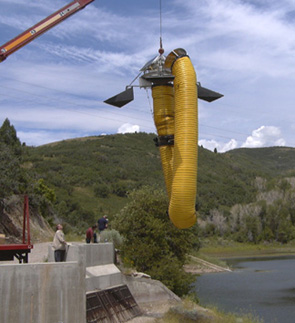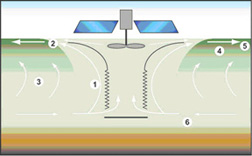|
|
|
||||||
|
|
Aeration circulation device to freshen water stored in the reservoir September 23, 2004
( As a result of 5 years of drought, Salt Lake City Department of Public
Utilities (DPU) has stored conserved water supply in Little Dell and In an effort to avoid water quality problems in Mt. Dell Reservoir, which
supplies water directly to the Parley’s Water Treatment Plant, DPU sought a
means of de-stratifying the water layers within the reservoir and keep the
reservoir water mixed. DPU water quality administrator Florence Reynolds and
her staff reviewed alternatives to achieve the objectives, and selected a
treatment device manufactured by SolarBee®. The
treatment device was installed in Mt. Dell Reservoir on July 15, 2004.
Looking much like a moon landing device with solar panels floating on the surface of the reservoir, the SolarBee® circulates the water to a depth of 100 feet deep. at pumping rates up to 10,000 gallons per minute. It is silent, solar powered and has no infrastructure requirements. Ideally, the unit will allow for the mixing of the reservoir so that the lake doesn’t stratify, turn over the heavy nutrients at the lake bottom and cause algal blooms. These blooms impact the treatability, and esthetic qualities ( taste and odor) of the water. According to Reynolds, “Its our hope that by being pro-active we can halt or control eutrophication in the reservoir.” She adds, “It is more effective to treat the reservoir water so as to avoid water treatment problems and possible taste and odor problems in the water distribution system.” Two month’s data indicate that the SolarBee® is meeting DPU’s expectations. Turbidity, temperature and dissolved oxygen data show that stratification within the reservoir is not taking place since SolarBee® has been in operation. Additional information may be obtained from Salt Lake City Department of Public Utilities: florence.reynolds@slcgov.com |

